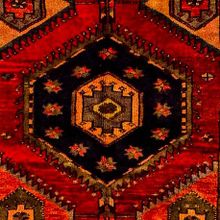Difference between revisions of "Meshkinshahr Rug"
Jump to navigation
Jump to search
| Line 22: | Line 22: | ||
<!--Technical information--> | <!--Technical information--> | ||
| − | |Common designs = | + | |Common designs = |
|Common motifs & patterns = | |Common motifs & patterns = | ||
|Common sizes = | |Common sizes = | ||
|Common colors = Crimson, Green, Blue, Navy Blue | |Common colors = Crimson, Green, Blue, Navy Blue | ||
| − | |Dyeing method = [[ | + | |Dyeing method = [[Natural]], [[Synthetic]] |
|Pile material = [[Wool]] | |Pile material = [[Wool]] | ||
|Foundation material = [[Cotton]] | |Foundation material = [[Cotton]] | ||
|Weaving Technique = | |Weaving Technique = | ||
| − | |Knot type = [[ | + | |Knot type = [[Symmetrical]] (Turkish) |
|Knot density = | |Knot density = | ||
| Line 37: | Line 37: | ||
Meshkinshar rugs origunate from Meshkinshahr, located west of Ardabil in northwestern Iran. Nomadic people live in the region where they are chiefly occupied with rug weaving and agriculture. This region of Iran was invaded by Mongols during the 13th century, bringing with them a very bold style of rug weaving and the predominant use of the Turkish knot. Most Meshkinshahr rugs are very long lengths which lend themselves perfectly for use as stair runners. Although the use of stair runners is much more prevalent in the United States than in Europe, they are gaining in popularity. Stair runners improve safety by providing traction on the stairs, in addition to protecting your wood from wear and tear, and quite effectively reducing noise. | Meshkinshar rugs origunate from Meshkinshahr, located west of Ardabil in northwestern Iran. Nomadic people live in the region where they are chiefly occupied with rug weaving and agriculture. This region of Iran was invaded by Mongols during the 13th century, bringing with them a very bold style of rug weaving and the predominant use of the Turkish knot. Most Meshkinshahr rugs are very long lengths which lend themselves perfectly for use as stair runners. Although the use of stair runners is much more prevalent in the United States than in Europe, they are gaining in popularity. Stair runners improve safety by providing traction on the stairs, in addition to protecting your wood from wear and tear, and quite effectively reducing noise. | ||
<!-- from Rugman Archive:https://web.archive.org/web/20071013130415/http://www.rugman.com:80/Content/meshkinshahr.html --> | <!-- from Rugman Archive:https://web.archive.org/web/20071013130415/http://www.rugman.com:80/Content/meshkinshahr.html --> | ||
| − | [[Category: | + | [[Category:Ardabil Rug and Carpet]] |
| − | |||
[[fa:قالی_مشکینشهر]] | [[fa:قالی_مشکینشهر]] | ||
Revision as of 09:37, 2 March 2020
| Meshkinshahr Rug | |
|---|---|
 Design of Meshkin Rug (Rugman) | |
| General information | |
| Name | Meshkinshahr Rug |
| Original name | قالی مشکینشهر |
| Alternative name(s) | Meshkinshahr Carpet (Meshkin Rug) |
| Origin | |
| Category | Village |
| Technical information | |
| Common colors | Crimson, Green, Blue, Navy Blue |
| Dyeing method | Natural, Synthetic |
| Pile material | Wool |
| Foundation material | Cotton |
| Knot type | Symmetrical (Turkish) |
Meshkinshar rugs origunate from Meshkinshahr, located west of Ardabil in northwestern Iran. Nomadic people live in the region where they are chiefly occupied with rug weaving and agriculture. This region of Iran was invaded by Mongols during the 13th century, bringing with them a very bold style of rug weaving and the predominant use of the Turkish knot. Most Meshkinshahr rugs are very long lengths which lend themselves perfectly for use as stair runners. Although the use of stair runners is much more prevalent in the United States than in Europe, they are gaining in popularity. Stair runners improve safety by providing traction on the stairs, in addition to protecting your wood from wear and tear, and quite effectively reducing noise.